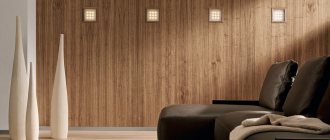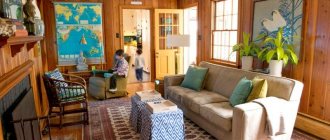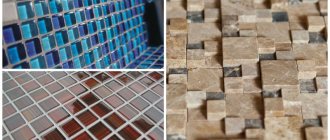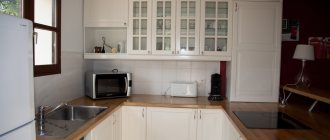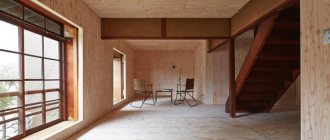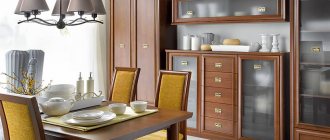What interiors can be decorated with wood?
Wood covered walls are more versatile than many people think and are not limited to rustic interiors. This design is very reminiscent of a ski resort or holiday home. It looks more upscale than wood siding.
This trend is ensured by the excellent performance and aesthetic qualities of wood.
Kitchen and living room
Wood goes well with all types of color palettes and work surfaces. It can be treated with natural oil. Then it will not contain harmful substances and will be able to maintain its antibacterial properties, which is important for hygienic storage of products.
The amount of wood in the decoration of this room is very variable, from highlighting the dining area with an accent wall to completely covering the walls.
When it comes to living rooms, wooden walls in the interior immediately attract attention when you enter the room. The tree and its appearance depend only on you. For example, whitewashed wood can suit a Scandinavian or minimalist style.
In a living room or office, wooden decoration is always appropriate and effective, and in addition, it emphasizes the status of the owner in front of his guests.
Bedroom and children's room
A wooden wall in the bedroom brings more coziness and a warm feeling with the right decor: it can perfectly coordinate with pendant lights and hanging plants, providing a rustic chic style.
The best choice is light-colored breeds that create a soft, cozy and relaxed atmosphere.
The appearance of a wooden wall has a vintage style, texture and the ability to interestingly transform any children's room design. There is a huge variety of wood finishes, so you can choose colors for different parts of the nursery, creating a playful interior.
Calm, soft shades of wood are perfect for a child's room.
Bathroom
For the walls in the bathroom, you can use wood panels in the same tone and type of material as for the floor. But it is better to avoid using wood in your shower. In the shower, use neutral colored tiles. In the bathroom, wood paneling can also be used as an accent on one wall, while other walls can be simply painted or tiled. The bathroom, completely finished in wood, creates the impression of simplicity and conciseness.
The first thing to do is to choose moisture-resistant types of wood and be sure to be impregnated with a hydrophobic mixture.
Where do we focus?
For a wall made of boards, you need to choose a central and fairly open place, not cluttered with furniture. There are four win-win options: - the wall or part of the wall to which the head of the bed in the bedroom is adjacent; — TV area in the living room; - the wall behind the sofa in the living room; - dining area in the kitchen.
Use a ready-made solution, or find your own! By the way, if the apartment is equipped with a green garden or other recreation areas (for example, with an aquarium or an artificial fountain), a wooden wall will become both a thematic decor and a way to separate a corner of nature from the living quarters.
Types of wooden wall finishes
Wood wall decoration can be made in different materials, such as the options below.
Lining
Clapboard is a great way to add personality to a room. It is often used in salons or cafes to create a feeling of coziness. There are different options for clapboard finishing: from antique styles to modern interpretations. A simple interior lining with aged clapboard with decorative slats can create a unique charm for the room.
This simple solution can add coziness to the atmosphere of the room and make it brighter and more welcoming.
Board
If you want to radically change the appearance of your exterior walls, cladding them with planks is a great way to achieve this. But this is not just a cosmetic upgrade. External wall planking can benefit from providing additional insulation for a building project.
The board is suitable for Scandinavian, rustic and eco-style, as well as minimalism and chalets.
The boards are available in different color options. Deliberately aged boards are also popular. This small block cladding is a colorfast alternative to traditional exterior cladding. Created using reclaimed wood, plank siding requires minimal maintenance and provides years of durability.
Smooth calibrated elements will fit perfectly into a minimalist design, the main thing is not to overdo it with quantity.
Laminate
Like the plank panels that were popular in the middle of the last century, laminate panels can be installed horizontally on one or all walls. Vertical laminate panels visually increase the height in rooms with low ceilings. They can also be used for both residential and office wood finishing of apartments. Laminate flooring is easier to install than real wood planks because it is lighter and thinner.
This material is characterized by good stability and attractive appearance; it is often used for wall cladding in city apartments.
OSB
Oriented strand board is a versatile structural wood panel that has many of the strength and performance characteristics of plywood. The combination of OSB wood and adhesives creates a strong, stable panel that resists warping, delamination and defects. Relative to their strength, OSB panels are lightweight and easy to process and install.
This material is characterized by a pronounced and extraordinary texture. It is well suited for all lovers of modernism and avant-garde.
Parquet board
Any type of wood can be installed on the walls, including parquet. The advantage of hardwood parquet on walls is the same as for floors, since the wood is durable, can be painted and coated with protective agents. Parquet flooring can be used to create a variety of designs in different colors, patterns and finishes.
A wide variety of parquet colors allows you to create a unique interior with a creative idea at a reasonable price.
Ends and cuts
Even a section of a wall with ends can attract the eye. Wood paneled walls originated from the fact that recycled waste from some other products became one of the most popular wall coverings, and that particular waste was end grain and saw cuts. A careful examination of each such wall block reveals growth rings and variants of tree bark with individual painting.
Covering the wall with scraps of boards and round timber creates an extraordinary and very stylish look.
Wall panels for room decor
Quite often, a minimalist design requires warm accents, which is why wood paneling is relevant here. Walls and floors are receptive to color and tactile surface structures. There is a significant rationale for using wood as a material in areas where it has already proven itself over the centuries. With wall panels it is easy to create a trendy industrial look with a feeling of increased space, where the floor seems to flow smoothly into the wall.
This is a classic finishing material, which is often made to order according to specified dimensions.
Types of finishing
You can't just take some material and nail it to the walls of your house. Nothing good will come of this. Any finishing work involves several interconnected stages. The most important of them are rough and fine finishing.
- Insulation occurs around the entire perimeter of the house. All joints and seams, which are found in large numbers in wooden structures, are sealed. You can use putty for this.
- Windows and door frames are installed.
- The floor is being laid.
- The walls and ceiling are being prepared.
In any case, without these measures it is impossible to begin covering the walls. Violation of this principle leads to the fact that work is superimposed on one another, and none of them can be completed with truly high quality.
Today, manufacturers of finishing materials offer a wide range of products for interior finishing of a wooden house. The main reasons for such finishing measures are the need to protect the house from possible fires, to additionally insulate it, and the best way to sheathe the walls inside a wooden house depends on the financial capabilities of the owners and their taste preferences.
How to choose quality materials for interior wall cladding
You can choose different wood: aged, classic panels or recycled wood. However, you should be careful with its use. The simultaneous use of a large number of different types of wood creates a feeling of chaos in the space. It is much better to use one type of wood with detailing on another type that complements it. For example, the interior could be clad in light spruce paneling with larch trim.
By following simple design ideas, you can give the interior a certain stylistic direction.
Possible materials for the manufacture of wood wall panels:
- Natural wood panels. Most often made of oak, cedar, maple or alder.
- Chipboard. The manufacturing process is based on the method of hot pressing of chips and sawdust.
- Fiberboard panels. Also made by hot pressing, but using wood and other plant fibers.
- MDF panels. This is a relatively new material based on MDF boards using dry pressing at high temperature and pressure.
Natural wood is combined with modern elements: metal or glass panels and inserts.
Approximate cost of material
The table below shows the approximate cost of wood from which planed finishing material can be produced.
| Hardwood: | Cost per m2: | Coniferous wood: | Cost per m2: |
| Linden: | From 700 rub. | Larch | From 750 rub. |
| Alder: | From 900 rub. | Cedar | From 550 rub. |
| Oak: | From 3000 rub. | Pine or spruce | From 350 rub. |
| Ash: | From 1500 rub. | ||
| Aspen: | From 1200 rub. |
How to make a wall with plank cladding with your own hands
What tools will you need:
- Panels.
- Wood filler.
- Varnishing or painting.
- Universal glue.
- Electric drill.
- Saw.
- A hammer with a forked end.
- Quadrant.
- Level.
Stages of work:
- Choice of cladding.
It comes in various lengths and thicknesses, but the tongue and groove method is most often used. There are many renowned cladding systems to choose from. Some need to be secured with pins, others are secured with glue.
Wall panels are an integral attribute of the classic style, chalets, English and American styles of decoration, as well as art deco.
Unfold the lining and lay it on its side. Leave the wood in the room to be re-lined two weeks before renovation. This helps the material acclimate and shrink before installation. If necessary, carefully remove the baseboard and trim from the wall. If you need to reroute any plumbing, do so before installing the trim.
- Attaching the planks.
A timber batten is a piece of treated lumber used to support siding. You need to nail the wood slats to the wall or ceiling before attaching the cladding. But if the work area is level, simply using glue is enough. Attach the wider slats to the wall.
We attach the frame for the wooden panels to the wall.
If you are finishing with plaster, the planks should be 22mm high and 50mm wide. For facing brickwork or lath, the height should be 38mm and width 50mm. Attach the slats to the wall or ceiling at 90 degree angles, at 400mm intervals. If the slats run horizontally, place the lowest one just above the baseboard level. When installing ceiling strips, make sure they are securely attached to the beams. Marking the position of each beam on the ceiling will make the job easier.
- Preparation: Sanding and coating the cladding.
Before attaching the trim to the battens, make sure the surface of the trim is smooth and ready for your chosen finish. Sand the outer surface of the cladding and remove dust. Then wipe the surface with a clean, lint-free cloth dampened with spirit. Apply two coats of your finish to the front and back of the board to prevent distortion of the wood.
Wall panels can be attached in two ways: on the lathing or directly on the wall using glue.
Do not coat the inside of the groove. Apply the final coats only when you have cut and secured the boards. Mark the boards at your chosen height with a knife or pencil. Mark 45 degree angles using a custom quadrant. It is important to place the corners correctly. Use the same technique to mark and cut the boards to length. Remove any rough edges with sandpaper. Apply two coats of your finish to the front and back of the board to prevent distortion of the wood.
- Correction of cladding.
Choose your starting point. Working from left to right, place the first board against the wall. Use a level to check the position of the board. Insert the pins through the board and into the batten. Then drive in the studs, one per plank. Place the next board in place. Use a 50mm wide offcut board - cut off the groove side to protect the tongue of the new board while making it easier to slide it into place with light hammer blows. Secure with a pin. Check the corners.
Unusual styling options will add warmth and comfort to your interior, while adding a touch of luxury.
- Completion.
Install the baseboard and any other moldings. They must be pre-treated in the same way as cladding. Secure everything in place with panel adhesive. Carefully fill all the dowel holes with wood filler that matches the color of the wood. Don't spread the filler around too much. When the litter is dry, lightly wipe it. Finally, apply one or two coats of treatment.
Coating wood with wax helps preserve the natural shine and integrity of the material.
Useful tips from designers on wood paneling
Once you have an idea of the style of your space, you can better choose the right woodwork and finishes. If you do not take into account the style, then an important point is the color scheme of the interior. If a color scheme is already in place, the choice of panels should match the wood furniture or trim chosen. A wood color that is too dark can visually dull the rest of the room.
This technique is well complemented by lighting fixtures that illuminate not the entire room, but only individual zones.
A good rule of thumb: If you want the space to feel open, airy and light, stick to natural, lightly stained wood. If you want a little depth and drama, consider a darker dyed material.
A wall trimmed with scraps of wooden boards looks very original.
Toned and varnished board
The way the board is processed is important - it is coated with a matte finish (varnish or wax - not visible) and slightly tinted. This makes it look more modern. The result is obvious. Although there are a lot of boards, almost all the walls are finished, the interior still does not look at all like a bathhouse or a country house.
The photo below shows the same bedroom - pay attention to the quality of the installation.
Glossy varnish is not at all in fashion now, so if you like the golden-honey color of wood, but don’t want the effect of a country house, treat the board or lining with a matte finish (varnish, wax, oil) - it will look more modern.
If the lighting in the room allows, you can tint the lining in any shade of brown. You shouldn’t choose ones that are too dark, but the ones in the photo on the right and the photo below are very good, they are very warm and cozy.
Brown wood is very rich in shades, bewitchingly beautiful, but that is why you need to be even more careful with it. Too much brown can really darken a room, as you can see in the photo below.
This recommendation is more likely addressed to owners of wooden houses - if you leave your ceiling wooden, do not tint it the same brown color as the walls, make it much lighter so that there is more light in the room.
Brown board
If you want to decorate a wall with clapboard or brown boards in an apartment, then limit yourself to only one wall, and make the remaining walls white or very light so that it remains light and so that there is a pleasant contrast with the wall. Add white elements as in the photo above.
A brown tree can turn into different shades - chocolate, red, burgundy, green, yellow. Therefore, choose the decor for a room in which the wall is decorated with clapboard, so that all the colors are combined with the main dominant shade of your brown.
Interesting examples of interior design with wood
Wood adds warmth and softens the color contrast in the home. Interiors made from this material are also crucial for creating unique accents. Over the years, wood has become one of the popular natural materials used by humans.
The main thing to remember is that proper installation and high-quality coating of the cladding will extend its service life.
Current interior design trends with wood paneling bring the home closer to nature, such as using decorative accessories made from branches and logs. If you combine wooden decor with images of trees in the painting, as well as wood panels on the walls, you will create a natural feeling of cleanliness and eco-friendliness.
